Excerpts from Jim Conrad's
Naturalist Newsletter
from the March 31, 2008 Newsletter issued from Mexico's Southernmost State, CHIAPAS
ARMY ANTS AT DUSK
Wednesday night as I sought my sleeping spot in the reserve I came upon a black, seething mass of army ants. I've told about army ants before, but then I had no camera. Now you can see what I saw that night below:
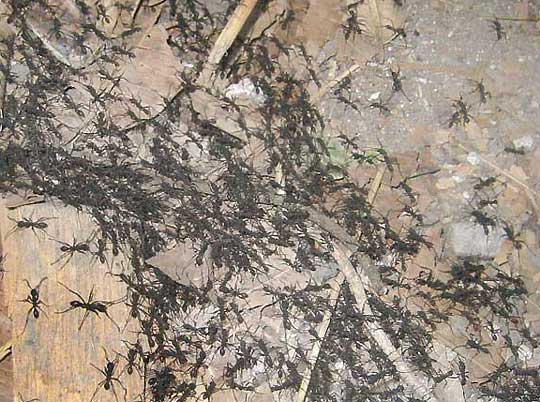
What's missing in the picture is the movement. The whole mass of ants, which was about the size of a large kitchen table, constantly changed its shape like an amoeba and consisted of several ant streams, some streams flowing in directions contrary to the others. Here and there black knots of ants coagulated and melted away in just seconds, and I figured that these represented "false alarms," something having triggered an attack, but then there was nothing. Though individual ants moved fast, the movement of the whole ant mass was slow, at that time seeming indecisive about which way to go. To get the picture I held the camera as far away from my body as I could, but still a few soldiers on the perimeter climbed my legs and bit.
Basically the idea behind army ants is that as a colony moves across the landscape it stirs up small animals, especially insects, a few of whom always escape in the wrong direction and then the ants quickly dismember them. I've read that army ants have been known to consume animals as large as goats but the largest animal I've ever seen them tear apart was a grasshopper, which disappeared chillingly fast.
In the picture you can see at least two ant sizes. Note how the larger ants usually appear at stream edges. It looks like they're keeping the smaller ants from wandering away from their streams, but who knows?
from the October 3, 2010 Newsletter issued from Hacienda Chichen Resort beside Chichén Itzá Ruins, central Yucatán, MÉXICO
ARMY ANT VIDEO, & HONEYBEES
All week a battalion of army ants has circulated in the area and it hasn't been easy on my ankles. Usually I don't realize I've wandered into their seething black currents moving across the ground until they've started biting, and then they hold on until they're picked off. We've met army ants here often enough, but what's new this time is that I remembered that my dandy little digital camera has video capabilities, so I filmed this week's invasion streaming across a portion of ground. Maybe you can see that below.
Luis who produces the milpa, or traditional cornfield, told me what he watched them do. A big wave of them crossed his milpa one morning, climbed two or three big Piich trees and found nothing, but then high up another Piich they found a big cavity holding a colony of Africanized Bees -- "Killer Bees," as the press calls them. The ants immediately set about cutting the bees to pieces.
"They'd walk up to a bee and with their big jaws cut the bee right across the midsection. The bee's parts fell to the ground, where other ants were waiting to carry them away. Beneath the tree it was like a dry rain falling, but it was pieces of honeybees. Those ants wiped out the whole colony, then ate the honey, left, and didn't come back.
from the January 16, 2005 Newsletter issued from Komchén de Los Pájaros near Telchac Pueblo, western Yucatán, MÉXICO
ARMY ANTS
The other morning I was weeding the lettuce when gradually it dawned on me that over to my right the ground was moving. It was an advancing front of army ants and I didn't have much choice other than to turn the lettuce patch over to them.
Unlike the leafcutter ants I told you about earlier, which can carry away every bit of leaf and flower material in a tree or garden, army ants are carnivorous, not vegetarian, so my lettuce was safe. As the ant-front advanced I watched as worker ants fastidiously searched beneath every lettuce leaf, in every crevice in the ground, and around the corner of every stem. Any small animal that couldn't get away was doomed. I've read that army ants can dismember and devour animals as large as goats, but the largest thing I've ever seen them tear apart was a grasshopper. And you should see the grasshoppers springing from the grass as a wave of ants moves through it.
I read that army ants, though possessing simple eyes, are blind. The blindness doesn't seem to hinder them at all. In fact, as you witness their amazing degree of organization and cooperation, it's easy to believe that they may have senses, or experience a sophisticated manner of being, we humans can't even imagine.
Once I spent a summer living next to a family in the Nahuatl-speaking country of eastern San Luis Potosí, in east-central Mexico. That family by no means suffered Alfred Hitchcock moments when army ants invaded their house. In fact, they seemed to rather like it. First, it meant that they could abandon the day's chores, go sit in the park, and if someone asked them why they were being so lazy in the middle of the day they could just say "ants" and everyone would understand.
Second, army ants do a great job cleaning houses of scorpions.
from the February 13, 2005 Newsletter issued from Komchén de Los Pájaros near Telchac Pueblo, western Yucatán, MÉXICO
ARMY ANTS & TARANTULA
Approaching Komchén's main living area on Monday morning I found a bit of commotion. A dark smudge of army ants was swarming across the shop's walkway into the bushes before the library. Ana María and Lino were on hand and I heard Ana María exclaim "Pobrecita"
("Poor little thing...") as she rushed to the ant- smudge front and scooped something into her bare hands.
She'd saved a mature tarantula somewhat larger than the top of a coffee cup. It was a black one with long, stiff, red-orange hairs mantling her abdomen. The creature had been chased from her nest by the ants and at that point 20-30 ants were still on her, tearing at her body. Ana María carried her to a quiet spot, put her down, and set about squirting water on the ants, trying to redirect them away from where guests were sleeping.
The tarantula remained where Ana María placed her for at least 20 minutes, moving not at all as the ants continued trying to dismantle her. However, the ants couldn't get past the creature's stiff, sharp hairs. The ants did manage to cut two small bunches of hairs from her, fashion them into rough balls, and begin moving the hair-balls through the grass.
However, now those ants had been separated from the main ant swarm and were receiving no chemical instructions from their peers, so they really had no idea where to go with their booty. Eventually they just wandered off individually, directionless. As the tarantula found herself more and more free of ants she began twitching her legs, clearly getting ready to move on. Sad for her, even if she could find her nest again, her babies had surely been cut to pieces and carried off by the ants.
So, that morning, both army ants and tarantula had had their lives drastically rearranged. Ana María had interviened on behalf of the tarantula, but I had just stood there watching, feeling equally allied to ants and tarantula.
One other thing -- as the army ants continued advancing through the herbage, some Hooded Warblers and Ovenbirds overwintering here from North America appeared to be having some fun. They fed on many small insects abandoning their hiding places as they tried to escape the ant hoards.
from the April 4, 2010 Newsletter issued from Hacienda Chichen Resort beside Chichén Itzá Ruins, central Yucatán, MÉXICO
CINNAMON-SMELLING ARMY ANTS
The other day I was on my hands and knees watching a stream of army ants pass beneath me when this thought came to me: Sometimes when I've been in really anty situations I've smelled the ants' formic acid. If I should very gingerly smell this surging river of ants, would it smell like that?
I put my nose as close as I dared, sniffed, and smelled cinnamon.
I sniffed several areas nearby and smelled no cinnamon. I went to other parts of the ant stream and once again smelled cinnamon.
I've never heard of ants smelling like cinnamon. Has anyone out there?
We've seen streams of army ants before, but if you want to see a tiny part of one of this week's fast-moving, cinnamon-smelling streams passing over a rock, below:

from the October 16, 2011 Newsletter issued from Mayan Beach Garden Inn 20 kms north of Mahahual; Caribbean coastal beach and mangroves, ~N18.89°, ~W87.64°; Quintana Roo state, MÉXICO
ARMY ANTS ON THE WHITE SAND ROAD
The other day on the white sand road I biked upon a battalion of them streaming across the road in three or four lines that merged and separated from one another like intersecting superhighways. You can see them, flowing from right to left, below:
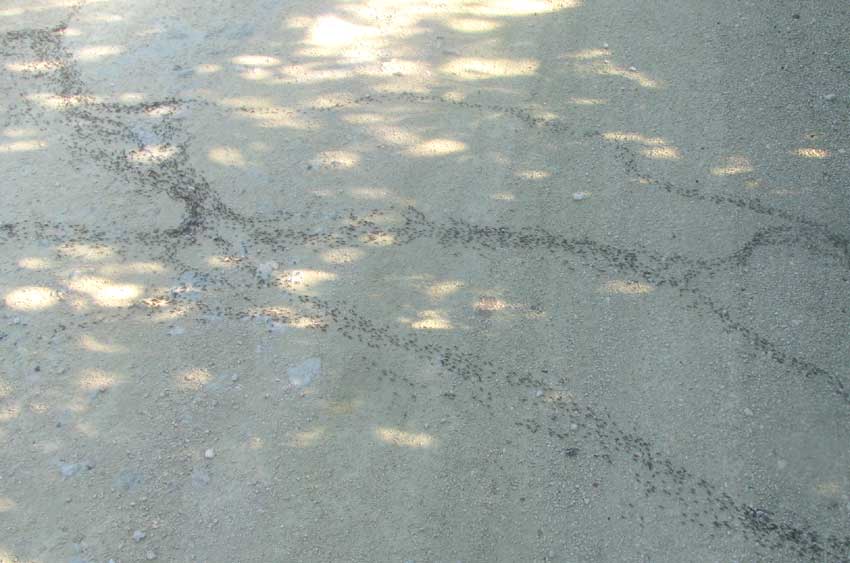
from the November 6, 2011 Newsletter with material from Mayan Beach Garden Inn 20 kms north of Mahahual; Caribbean coastal beach and mangroves, ~N18.89°, ~W87.64°; Quintana Roo state, MÉXICO
ARMY ANTS EN MASSE
Sometimes army ants move en masse, as seen on the white sand road last Sunday near Mayan Beach Garden, shown below:

That ant-blob was about the size of a large car with most but not all ants moving from right to left. My impression is that the same army-ant species sometimes moves in lines, sometimes in broad waves. Moving in a few narrow lines seems to be the quickest and safest way for them to get around, but moving en masse they are more likely to stir up insects such as grasshoppers who jump from one place to escape the ants only to land amid a bunch of ants.
from the August 21, 2016 Newsletter issued from Hacienda Chichen Resort beside Chichén Itzá Ruins; limestone bedrock; elevation ~39m (~128ft), N20.675°, W88.569°; central Yucatán state, MÉXICO
IDENTIFYING ARMY ANTS
Tuesday as I worked in the hut at the computer, something began biting on my ankle. It was a burning, pricking feeling that vanished soon after I brushed away whatever it was causing it. While I was bent over scratching the bite, from the corner of my eye I noticed that the hut's pole wall next to my head somehow seemed to be fluttering or oscillating. When I reared back and looked, I saw that once again army ants were sweeping through. Below, you can see a small part of the hut's interior wall, where the tops of the wall poles meet the thatch roof, with ants swarming into nooks and crannies looking for prey such as spiders and scorpions:
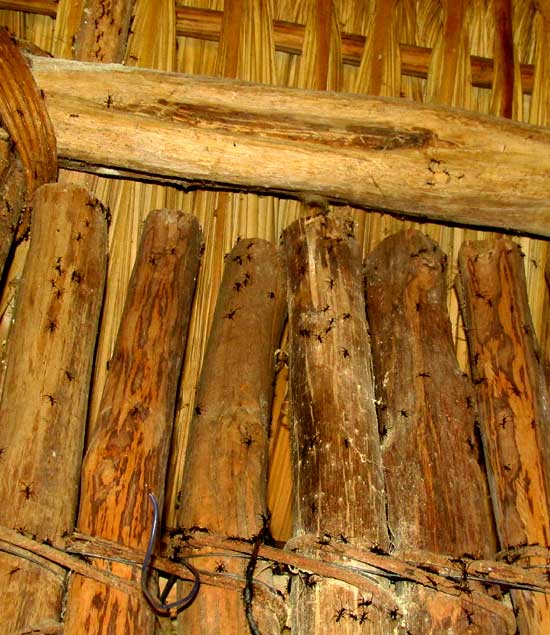
Having run into army ants many times, we've put together a pretty good page on them, at www.backyardnature.net/mexnat/armyant.htm
However, we've never tried to identify them, so this week I've been looking at them taxonomically. In preparation for the task I took many close-ups, but it was hard getting clear pictures, since they were moving fast and I wasn't about to kill one just so I could take its picture. Still, the images show the ants' general form. Below, you can see a scurrying worker:
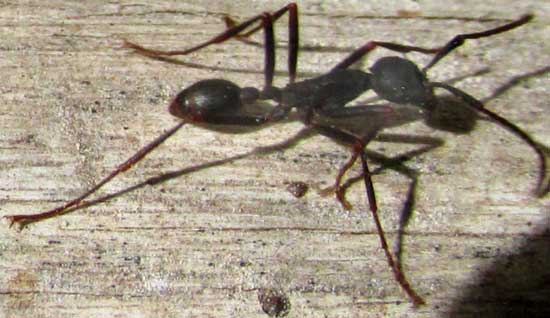
A worker photographed from above is shown below:

That image proved to be the most important one, for it shows that the back of the head is affixed with low, backward-pointing projections, that the end segment (abdomen) is hardly bigger than the head, and that the chest area (thorax) is broadest at its middle, gradually diminishing toward the head, which it joins with a narrow neck. The narrowed thorax front is unusual among army ant species.
Wikipedia's Army Ant Page does a good job introducing the subject. There we learn that over 200 ant species are considered to be army ants, but that different ant groups have independently evolved the roving, base-shifting behavior that qualifies a species as an army ant -- convergent evolution.
Learning that most New World army ants belong to the ant subfamily Ecitoninae, a Google search was made for research papers on Mexican Ecitoninae. This turned up the 2004 paper "Las hormigas Ecitoninae (Hymenoptera: Formicidae) de Morelos, México," by Quiroz-Robledo and Valenzuela-González. Mainly using that paper's line drawings of worker ant outlines as seen from above, and noting especially the backward-pointing projections at the back of the head, and the narrowed forward part of the thorax, the best match for the species was NEIVAMYRMEX CORNUTUS.
That paper was based on work done in the south-central Mexican state of Morelos, and there's a good possibility that here in the Yucatan we have other army ant species. Neivamyrmex cornutus is endemic just to Mexico. In Morelos the investigators saw the species preying on a termite colony, and in turn saw spiny lizards preying on the ants.
Despite the uncertainty, here we'll file this page on the Internet under Neivamyrmex cornutus, knowing that someday other researchers will confirm or correct the ID, and be happy to see the pictures and read about the species that visited a hut in the Yucatan, and spent most of the day streaming here and there in the hut's backyard.
from the December 11, 2011 Newsletter issued from Hacienda Chichen Resort beside Chichén Itzá Ruins, central Yucatán, MÉXICO
WASPS VS ANTS
When I arrived back at the hut about five weeks ago a new resident in the neighborhood nested in the hut's roof thatch about four feet east of the door, as seen below:
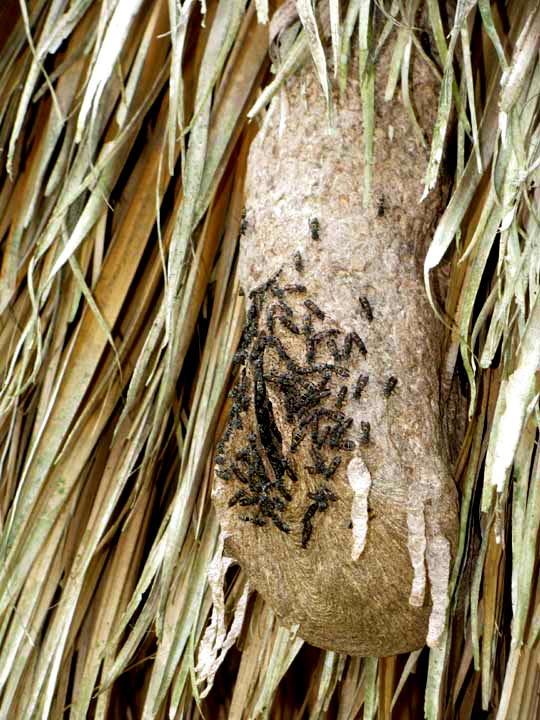
Upon my arrival the wasps were constructing the interior combs in which they'd raise their brood, but soon they began covering the combs with their coarse, gray paper made from chewed wood pulp. I watched the nest slowly take form day after day. You can see some wasps milling about their finished nest entrance below:
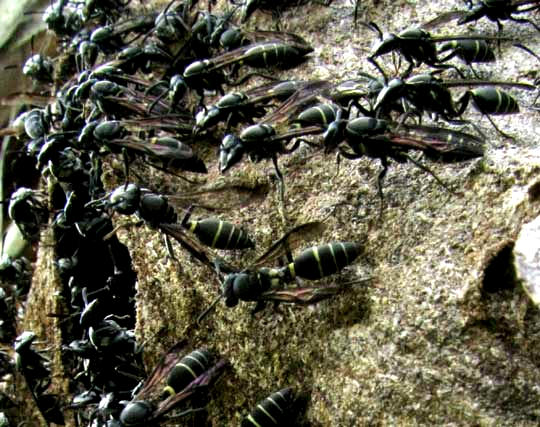
The wasps, which can deliver a moderately painful sting, never bothered me, always letting me stand close and watch, only occasionally darting at my face if I got too close, not stinging. The Maya, who accuse most reptiles and arthropods of every kind of devious and malicious intent to injury, admit that these wasps, which frequently live in their own hut thatch, hardly ever sting a hut's occupants. They say the wasps learn the hut owner's scent, and that only visitors need to take care.
And then about midday one day this week I returned to the hut to find a cloud of wasps buzzing around the nest, while on a Tree Cotton bush directly before the nest hundreds of them clustered as shown below:
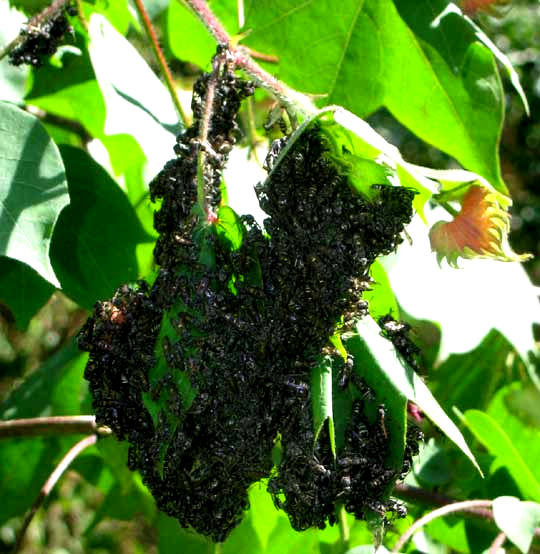
If they'd been bees, I'd have thought that somehow already the little nest had produced a surplus population and now a new queen was leading part of the nest to someplace else where a new nest would be founded. However, I wasn't sure if wasps did that. I looked more closely at the nest.
The nest was swarming not with wasps but with ants. Fair sized ants poured out of the thatch, rushed across the nest's surface into the nest's teardrop-shaped entry hole, while others were already leaving the hole carrying white, paperlike flakes. The flakes were borne to the nest's bottom, where they were released into the air to flutter to the ground. Then the ants returned to the hole. At first I thought the flakes were wasp wings but up close I saw that they were the coverings of brood cells.
The wasp nest was being overrun by ants. Part of the wasps had escaped and now clustered on the Tree Cotton while the ants methodically tore apart the nest's interior chambers holding developing wasp pupae. Then ants began exiting the hole, not very tenderly dragging larvae beneath them, their sharp, ice-tong-like mandibles stuck into the pupae as shown below:
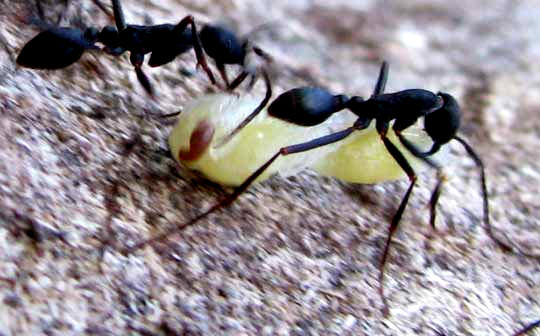
During this slaughter relative larger, red-headed soldier ants positioned themselves at the perimeter of action, their rear ends hunched beneath them as if they could sting, and their powerful mandibles open like incurved pincers ready to stab inwards, seen below:

In about half an hour the wasp swarm in the Tree Cotton departed. Until darkness fell the ants continued ripping open larval cells and carrying out white pupae, presumably to be butchered and distributed at their leisure. These larger, red-headed ants have been identified by iNaturalist user "mettcollsuss" as ECITON BURCHELII ssp. PARVISPINUM.
The next morning the nest was empty, and quiet. During subsequent days from time to time wasps came and briefly surveyed the nest, but then flew away. Today the nest remains silent and abandoned.
from the August 23, 2018 Newsletter issued from Rancho Regenesis in the woods ±4kms west of Ek Balam Ruins; elevation ~40m (~130 ft), N~20.876°, W~88.170°; central Yucatán, MÉXICO
ARMY ANTS IN THE REFRIGERATOR
It was late in the day, a storm was about to hit, and when I came to the hut to fix a bowl of granola to enjoy while watching the storm, I opened the junked storage-refrigerator's door to find several hand-sized masses of fair-sized black army ants scattered here and there, with winding lines of fast-moving individual ants connecting them. Apparently the roving army had decided to bivouac before the storm hit, and my refrigerator, which until now I'd thought was more or less insect-proof, was handy. Below, you can see the corner of one mass at the edge of my plastic egg container:
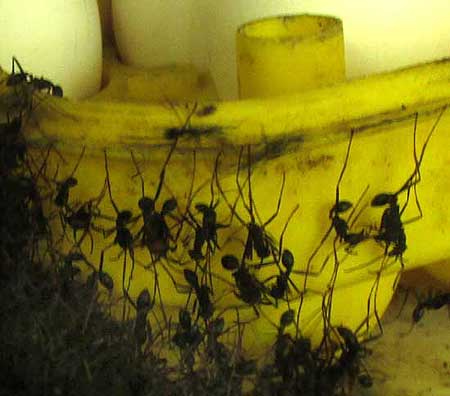
Notice that certain ants are hanging upside-down with their back legs hooked on irregularities on the egg container's surface and maybe other ants, and that some ants are atop others. Outside the refrigerator, where one corner overhung the rock it was propped up on, a better developed blob had formed, this one dangling and composed of several layers of ants dangling from other ants, seen below:

These pictures aren't so good, but the late afternoon, stormy weather light was so limited that I had use a slow shutter speed (1/6th second), the ants were moving fast, and several were biting me. The most blurry picture, below, shows an army ant stalactite forming inside the refrigerator

Over the years I've learned to let army ants do what they want to. If they invade the hut, just leave the hut until they're gone, having cleared out all the spiders, tarantulas, scorpions and the like. However, that day it had begun raining hard, so the ants and I lived together awhile. I upset them a little chopping firewood and jarring the floor, and then they didn't like my campfire's smoke, so by the time it stopped rainy we were all agreed that they needed to move on, and they did.